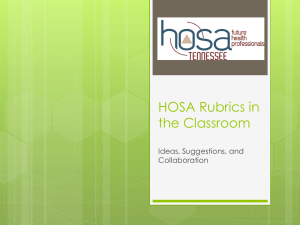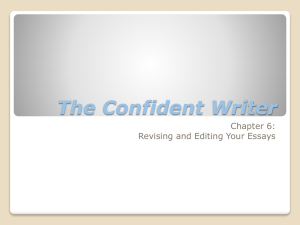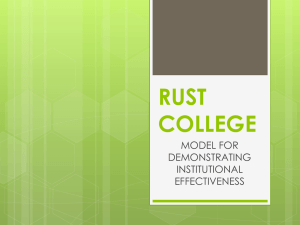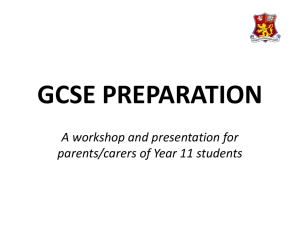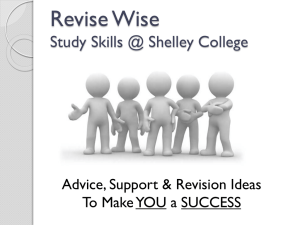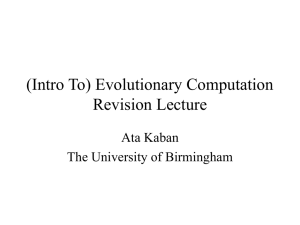Step 4. Create or Revise the Assessment
advertisement
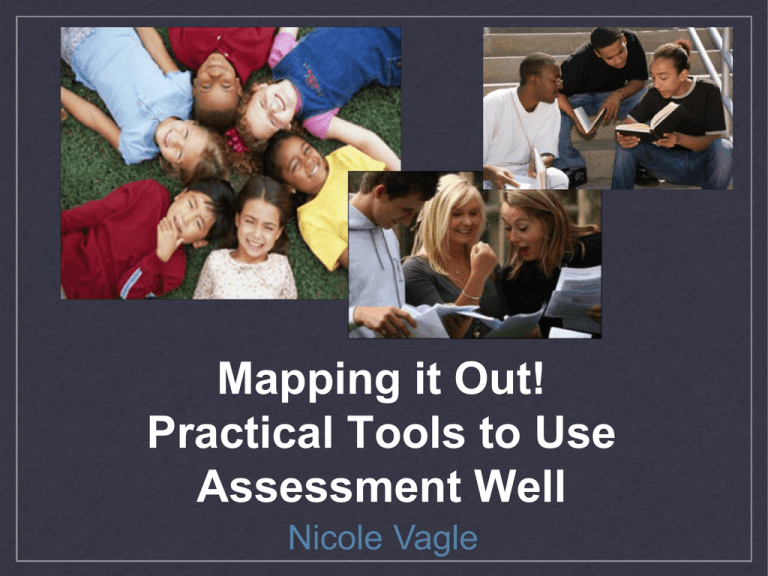
Mapping it Out! Practical Tools to Use Assessment Well Nicole Vagle Our Work Together... • What are key elements of quality assessment design and use? • How do we use the design in five process to facilitate the design and use of aligned assessments? • How do we design engaging assessment practices where students invest in their learning? *CLARIFY THESE Assessment CHARACTERISTICS Characteristics *Star 2 OR 3 STRENGTHS *Circle 1 OR 2 GROWTH AREAS Accuracy Clear Learning Goals/Targets Type (essay, project, presentation, multiple choice test, etc) of assessment reflects learning Accounts for bias, background knowledge, potential error Effective Use Clear communication about what assessment means in terms of learning Descriptive feedback provides clear next steps If graded (standards-based or traditional), the score reflects learning (not timeliness, effort, behavior, etc.) Student Investment Clear idea of quality and not-so-quality work Self-reflect on what the assessment means in terms of their learning (strengths and next steps) Set Goals based on assessment information Planned and implemented action (in partnership with teachers) to achieve their goal and improve Design in 5 TEACH OTHERS DONE SOME STUDIED IT NOT MUCH RATE YOUR experience in designing Assessments... Step 1. Determine the Big Picture & standards for the unit or time frame. Design in 5 Step 2. Sketch out (simple and complex) learning goals Unpack the standard by circling the verbs Underline key concepts (vocabulary and context) Write learning goals that represent the standard so they show relationship to the whole – simple to complex, criteria Step 3. Create an Assessment Plan Identify learning goals on the assessment. Determine each learning goal’s percentage of importance or indicate the number of items. Determine the type of method to best assess student proficiency of that learning goal. Step 4. Create or Revise the Assessment Write or refine items and tasks for each learning goal. Revise a current task to better reflect the learning required. Step 5. Determine the best use and reporting method. How will the information be used by students? What kind of score (if any) will best represent the achievement? Step 2. Finding Learning Goals USE THE VERBS IN THE STANDARDS TO WRITE SIMPLE AND COMPLEX LEARNING GOALS. o Unpack the standard by circling the verbs o Underline key concepts (vocabulary and context) o Write learning goals that represent the standard CREATE A LADDER OF LEARNING GOALS FROM SIMPLE TO COMPLEX STANDARD: STANDARD: Energy Standard I can explain different types of energy, including benefits and challenges. (F) I can create an energy plan for a specific location. (E) I can identify various types of energy. (D) I can apply what I know about energy to solve real-world situations. (C) I can compare and contrast how different energy plans would impact the economy. (B) I can define different types of energy. (A) STANDARD: Energy Standard I can create an energy plan for a specific location. (E) I can compare and contrast how different energy plans would impact the economy. (B) I can apply what I know about energy to solve real-world situations. (C) I can explain different types of energy, including benefits and challenges. (F) I can identify various types of energy. (D) I can define different types of energy. (A) Step 1. Determine the Big Picture & standards for the unit or time frame. Design in 5 Step 2. Sketch out (simple and complex) learning goals Unpack the standard by circling the verbs Underline key concepts (vocabulary and context) Write learning goals that represent the standard so they show relationship to the whole – simple to complex, criteria Step 3. Create an Assessment Plan Identify learning goals on the assessment. Determine each learning goal’s percentage of importance or indicate the number of items. Determine the type of method to best assess student proficiency of that learning goal. Step 4. Create or Revise the Assessment Write or refine items and tasks for each learning goal. Revise a current task to better reflect the learning required. Step 5. Determine the best use and reporting method. How will the information be used by students? What kind of score (if any) will best represent the achievement? Step 3. The Assessment Plan Matching Target to Method I can apply what I know about energy to solve realworld situations. •Multiple choice? •Short answer? •Essay? •Create a game •Present a speech KEY IDEA: Matching the Method to the Learning Goal Selected Response: Multiple choice, true/false, matching, short answer Essay/Constructed Response: Construct a solution, justify a problem solving method or respond to a prompt Performance Assessment: Produce, present or perform such as writing a paper, preparing or presenting a speech/presentation, participating in Step 1. Determine the Big Picture & standards for the unit or time frame. Design in 5 Step 2. Sketch out (simple and complex) learning goals Unpack the standard by circling the verbs Underline key concepts (vocabulary and context) Write learning goals that represent the standard so they show relationship to the whole – simple to complex, criteria Step 3. Create an Assessment Plan Identify learning goals on the assessment. Determine each learning goal’s percentage of importance or indicate the number of items. Determine the type of method to best assess student proficiency of that learning goal. Step 4. Create or Revise the Assessment Write or refine items and tasks for each learning goal. Revise a current task to better reflect the learning required. Step 5. Determine the best use and reporting method. How will the information be used by students? What kind of score (if any) will best represent the achievement? Step 4. Create or Revise the Assessment Step 1. Determine the Big Picture & standards for the unit or time frame. Design in 5 Step 2. Sketch out (simple and complex) learning goals Unpack the standard by circling the verbs Underline key concepts (vocabulary and context) Write learning goals that represent the standard so they show relationship to the whole – simple to complex, criteria Step 3. Create an Assessment Plan Identify learning goals on the assessment. Determine each learning goal’s percentage of importance or indicate the number of items. Determine the type of method to best assess student proficiency of that learning goal. Step 4. Create or Revise the Assessment Write or refine items and tasks for each learning goal. Revise a current task to better reflect the learning required. Step 5. Determine the best use and reporting method. How will the information be used by students? What kind of score (if any) will best represent the achievement? Student Investment WHERE AM I GOING? WHERE AM I NOW? HOW CAN I CLOSE THE GAP? SADLER, 1989 Student Investment... Practical Strategie Efficient & Effective Feedback Efficient & Effective Feedback PURPOSE Efficient & Effective Feedback PURPOSE RUBRICS FRAMED WITH POSITIVE LANGUAGE Rubrics Can Provide Feedback Efficient & Effective Feedback PURPOSE RUBRICS FRAMED WITH POSITIVE LANGUAGE PICTURE OF QUALITY Efficient & Effective Feedback PURPOSE RUBRICS FRAMED WITH POSITIVE LANGUAGE PICTURE OF QUALITY STEP TOWARD STUDENT REGULATION Efficient & Effective Feedback PURPOSE RUBRICS FRAMED WITH POSITIVE LANGUAGE PICTURE OF QUALITY STEP TOWARD STUDENT REGULATION COLLABORATIVELY WRITTEN COMMENTS Writing Collaborative Comments Efficient & Effective Feedback CONSIDER THE TIPS & EXAMPLES ON EFFICIENT & PURPOSE EFFECTIVE FEEDBACK... RUBRICS WITH POSITIVE *WHICH MIGHT BEFRAMED SOMETHING YOU WOULD try or share? LANGUAGE *OTHER ideas THAT EMERGE? (THINGS YOU’VE DONE, PICTURE OF SEEN, OR THOUGHT ABOUT) QUALITY *questions OR challenges THAT ARISE? STEP TOWARD STUDENT REGULATION COLLABORATIVELY WRITTEN COMMENTS Feedback from Students to Teachers is Powerful. (Hattie, 2009) CHAPMAN & VAGLE, 2011 Examples for Review Pause & Ponder How does the Design in 5 process help align and map assessment practices? Which aspect of the Design in 5 process is familiar and strong in practice? Which aspect of the Design in 5 process needs some focus? Why might this be important to consider in supporting your work? Nicole Vagle nvagle@gmail.co m Thank you.

